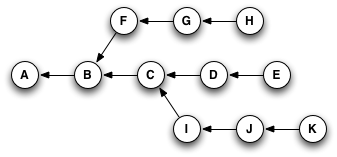Reachability
You can think of this graph as a set of three parallel universes with time flowing from left to right, so that A is the beginning of recorded history. (The arrow represents the "follows" or "is subsequent to" relationship, so you might say that "B follows A".)

To see an ASCII version of this graph, type
git rebase --help
If you start from E, the history you'll see is A, B, C, D, E.
If you start from H, the history you'll see is A, B, F, G, H.
If you start from K, the history you'll see is A, B, C, I, J, K.
But the really important thing about this is that no matter which node you start with, some parts of the graph will be unreachable to you.
That sounds kind of pessimistic, so I'll turn it around: Depending on where you start, you can reach parts of the graph that you couldn't get to otherwise.
This may not sound like much, but stay with me for a little while longer—it's huge.
- About This Site
- Git Makes More Sense When You Understand X
- Example 1: Kent Beck
- Example 2: Git for Ages 4 and Up
- Example 3: Homeomorphic Endofunctors
- Example 4: LSD and Chainsaws
- The Internet Talks Back!
- Graph Theory
- Seven Bridges of Königsberg
- Places To Go, and Ways to Get There
- Nodes and Edges
- Attaching Labels to Nodes
- Attaching Labels to Edges
- Directed Versus Undirected Graphs
- Reachability ←HEAD
- Graphs and Git
- Visualizing Your Git Repository
- References
- The Reference Reference
- Making Sense of the Display
- Garbage Collection
- Experimenting With Git
- References Make Commits Reachable
- My Humble Beginnings
- Branches as Savepoints
- Use Your Targeting Computer, Luke
- Testing Out Merges
- Rebase From the Ground Up
- Cherry-Picking Explained
- Using 'git cherry-pick' to Simulate 'git rebase'
- A Helpful Mnemonic for 'git rebase' Arguments
- The End
